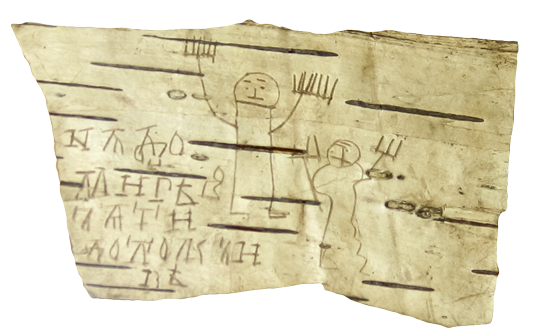The WhatsApp of the Middle Ages
Freiburg, Nov 28, 2018
The Department of Slavic Languages and Literatures of the University of Freiburg and the Russian Language Institute of the Russian Academy of Sciences began a partnership at the start of 2018 that is set to continue for several years. The linguistics' specialists are working in cooperation with computer experts to develop user friendly tools. The goal is to aid research into Church Slavonic, an old culture language in Slavic, Orthodox Christian countries.

A well-preserved cultural treasure: The "birch bark texts" are around 800 years old and tell of daily life. Photo: Wikimedia Commons
Achim Rabus points to the large set of bookshelves in his office. "As you can see, I read a great deal – and I like books," says Rabus, a professor of Slavic philology at Freiburg. With a glance at Prof. Dr. Olga Lyashevskaya, his colleague from Moscow, he adds, "Passion led us both to become linguists. Yet we're also interested in linking traditional and digital linguistics. It's all about developing computer programs that pave the way for a new quality in empirical, historical linguistic research." The actual language in this case is Church Slavonic. Because the grammar of Slavic languages is highly complex, there's a great need to further the development of taggers – as the programs are known in research. Taggers will allow more precise results to be reached in future. A team of about ten linguists is working with together with computer specialists to create programs that can learn independently.
Believers understand more
The Alexander von Humboldt Foundation is supporting the "Digital Paleoslavic" project, which can be classified under corpus linguistics. The researchers investigate texts with the help of taggers, among other tools. Taggers make it possible to search for specific types of words in the text in order to be able to determine the proportion of verbs, for example. The results of such studies are statistics and significant graphics that can depict the evolution of languages or differences between languages. "In Russia, right in Moscow, there are many outstanding philologists who are developing computer programs and applying them to pursue linguistic inquiry," says Rabus. "That's why we sought out a partnership with the institute in Moscow, because the tradition of linguistic research is strongly rooted there."
Church Slavonic dominated the literature of the Slavic-Orthodox region from the time of the Byzantine priests Cyril and Methodius, who in the ninth century were working as missionaries among the Slavic peoples, to the 18th century. For Slavs, Slavonic corresponds to Latin in Catholicism to some extent, with believers finding it easier to comprehend – something like Latin is for Italians. Yet it not only deviates from vernacular, which over the course of time increasingly found its way into Church Slavonic texts. It also shows considerable differences in a geographical respect and splits into diverse variants. What is more, spelling differs from region to region. The researchers are developing taggers based neural networks that are able to deal with all these variations.

The Slavic missionaries: Learned men and priests Cyril and Methodius brought Christianity to the people of the Medieval empire known as Kievan Rus'. Photo: Wikimedia Commons
Letters on birch bark
Programs like these are capable of analyzing a range of different types of texts, for example, religious scriptures but also legal writings, which mainly feature strongly local diction; or what are known as the "birch bark texts," which are up to 800 years old. They were found well-preserved near the city of Novgorod, where the damp climate helped keep them intact. These are letters, or writings, that tell of daily life – about financial problems or wedding plans – something like the WhatsApp of the Middle Ages. Plus there are chronicles. Lyashevskaya mentions the Novgorod Chronicle, which reports of the era of Ivan the Terrible in a hybrid language. Beyond that there are translations of the Bible, autobiographies and vitae – and the exemplary "Domostroi," a set of household rules written in vernacular and comparable to "Knigge," a German manual of etiquette.
Does the development of programs like this also have a practical use? "We're working on shaping user friendly programs and interfaces that are more than powerful tools, because that's the only way to improve their acceptance among philologists," says Rabus. When the cooperation partnership has come to an end, Rabus also points out, the results of the work will be discussed at a conference. And last but not least, he continues, the project is also expected to play a key role in German-Russian exchanges.
Hans-Dieter Fronz

